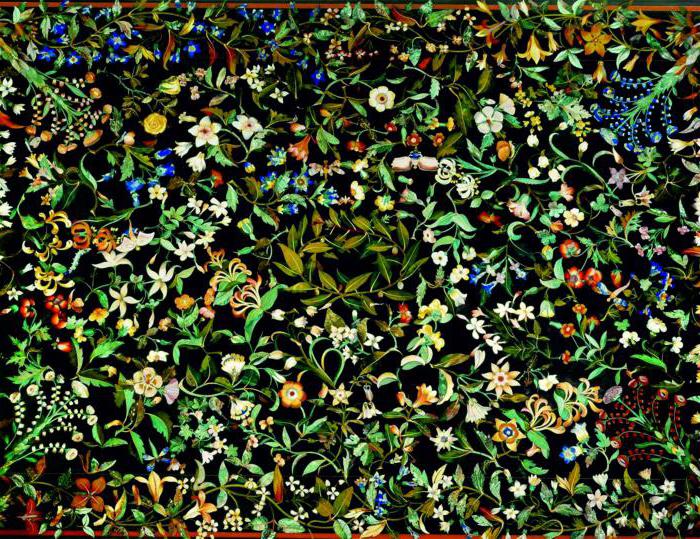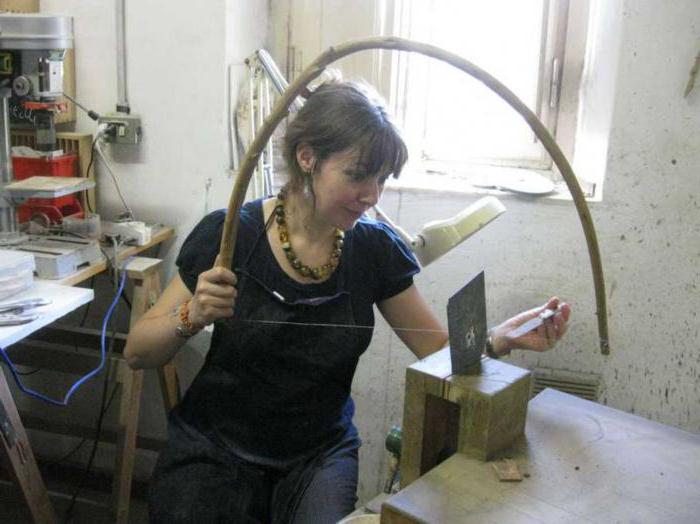Mosaic - the art of decorating furniture and architectural elements inside and outside the building with the help of individual elements of different nature, shape and size, known since a very long time.
There are several species, usually called by time and place of origin. Famous Roman, Byzantine, Old Russian, French mosaic. Florentine differs not only in the specific place of origin of this art, but also in technological features.
History
The first mosaic samples using natural stones date back to the fifth century BC. The decorative qualities of a stone, its strength, and the ability to maintain its original appearance over time have always attracted people. The best decorative qualities of this material are revealed by a mosaic. Florentine "stone painting" is one of the highest stages of such art. Most likely, such a decoration method appeared in the Middle East, at the turn of our era, but it got its name from the famous Tuscan city.

At the end of the 16th century, several stone-cutting studios were formed in Florence, in which masters invited from Milan worked. These workshops were created under the auspices of the famous family clan of the Medici, who ruled then in Florence. Representatives of this richest family have long collected the best examples of ancient art, and the technology of lining the surface with thin plates of semiprecious stone species arose largely from the need for restoration and restoration of outstanding examples of applied art of Ancient Greece and Ancient Rome.
Commesso
The art of creating stone paintings that arose in the cradle of the Renaissance, in Italian called commesso - "rallying." It involves a particularly precise fit of the parts that make up the mosaic. The Florentine picture is assembled from thin stone plates so that it is impossible to notice the seam between the elements. At the same time, the stone plate is selected based not only on the desired color, but also taking into account the natural texture. For example, for a leaf of a tree, a material is selected that imitates not only green, but also contains a suitable pattern of small veins, a bend of the leaf, etc., for the image of the fur, it is necessary that the direction of the "villi" coincide, etc.

In this sense, pietra dura (literally "hard stone") is another name for this art, similar to intarsia - inlaid from various species of wood. A set of wood veneer images is also a mosaic. Florentine inlay made of semiprecious stones is distinguished by a significantly greater complexity and almost unlimited time longevity of the result.
Technological process as art
Among the many tourists who come to Florence, excursions are very popular, including visits to famous workshops where the manufacture of Florentine mosaics takes place. For 200 € from a group you can personally witness how real masterpieces of decorative art are born .
At the same time, the work is carried out using authentic tools and devices that were used by masters of the 16th century, when this mosaic appeared. Photos of mosaic artists at work adorn the sites of numerous travel companies and travel reports of tourists from around the world. After that, you can admire the stone paintings made by masters of the distant past, which decorated many of the cathedrals and palaces of Florence, in particular the famous Medici Chapel.
Paints of stone painting
The palette used by artists creating masterpieces of the Florentine mosaic is not inferior in color and textural capabilities to that available to traditional painters:
- Lapis lazuli is rich shades of blue with white grains and sparkling crystals of golden pyrite.
- Malachite is an alternation of bands of gentle and intense greens.
- Marble - spectacular veins of different shades of yellow, brown, red and green.
- Semi-precious stones: agate, jasper, onyx, porphyry - represent a huge variety of striped, circular, clear and blurry textures, painted in various warm or cold colors, dense or having the character of subtle nuances.
With the help of these colors, an authentic Florentine mosaic is created. A photo cannot convey its true beauty, because the transfer of depth, which is revealed by polishing a stone, the play of light on the smallest crystalline inclusions, is inaccessible. Among poetic artists who have reached the pinnacle of mastery in this complex craft, there is a belief that when they use unique patterns created by nature in their compositions, the true beauty of the world created by God's will becomes available to them.
How it's done?
The creation of a small decorative insert on a small box or a huge decorative panel begins with a full-color full-size sketch. Large compositions are divided into small sections for convenience. The drawing is either cut along the lines into separate elements, or transferred to the stone with the help of tracing paper after the patient's search for the blank of the desired color and texture ends. The contour is made with the necessary margin for processing joints.

2-3 mm thick stone slabs are the starting material from which the Florentine mosaic is made. The technique of processing blanks manually does not change for many centuries. The plate with the applied contour is clamped in a vice, and the necessary part is sawn out using a special saw. It looks like a tight bow made from a tree branch (usually a chestnut or cherry) with a thin metal wire-string. In the process of cutting a stone plate, a special abrasive paste is constantly applied to the wire (before it was just a mixture of water and sand).
Then follows a careful adjustment of the individual parts of the picture among themselves. The result is considered achieved if the seam is not visible even in the light. The complexity of this stage can be imagined by looking at a mosaic depicting, for example, thin grape tendrils. The finished composition is glued to the base (in the authentic process - using wood resins) and carefully polished.
Timeless beauty
Italian mosaic reached its peak of popularity in the 17th – 18th centuries. Furniture, paintings and entire walls decorated with such a technique impressed with their exquisite and unfading beauty of people throughout Europe. Masters of Florentine mosaic appeared in many countries, including Russia. The greatest masterpiece created using inlaid stone is the famous Amber Room.
Today, the latest technologies and modern materials are used to make “stone paintings”. Individual parts are often cut with a computer-controlled laser. But even in this case, the Florentine mosaic remains a very laborious and expensive way of decorating. The creations of masters working in traditional handicrafts are appreciated at the level of the originals of classical painting.